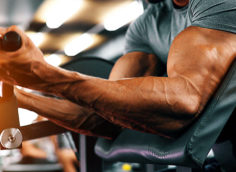The term "functional" is overused and frequently misused. However, it's an appropriate word for the type of strength most people are looking to build. Essentially, it means being strong in movements that are applicable to daily life.
Some would argue that all strength is applicable to daily life, but clearly there are exercises and movements that are more functional than others. For instance, the squat is activating muscles and executing movement patterns that are required to perform the same motion we use whenever we sit down or get up, while machine biceps curls only seem to activate the muscles used to take selfies.
When designing your programs, the easiest way to think of functional versus non-functional is to categorize exercises according to a continuum:
Standing → Sitting/Lying Down → Machine
or
Dumbbell → Barbell → Machine
Fortunately, if you focus on prioritizing free-weight compound movements, you're always on the upper end of the continuum. The other reason you want to favor compound or multi-joint movements is because they recruit the most motor units and generate a far bigger hormonal and neurological response.
This is also the case with choosing free weights over machines. For example, a barbell or dumbbell squat is a lot more stressful than a leg press and results in a more significant neurological response when matched for intensity.
Free-weight compound movements also permit a greater range of motion. A muscle is at its full range of motion when it's in its fully stretched or contracted position. More stretch and more contraction means more units recruited and greater muscle development. Though not all free weights allow full range of motion (e.g. barbell bench press), they generally provide ranges beyond what a typical machine provides. Plus, unlike machines, there's usually an alternative (like dumbbells) that provides greater range when necessary.
This also means free-weight compound movements are beneficial for injury prevention. The stronger our stabilizer muscles are, and the more familiar they are with loaded stress at various angles and ranges, the lower the probability of a pull, strain, or tear when placed in an over-stretched or over-extended position.





